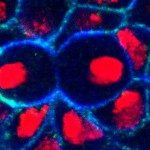Link to Pubmed [PMID] – 25365996
J. Cell Biol. 2014 Nov;207(3):351-63
Signaling and endocytosis are highly integrated processes that regulate cell fate. In the Drosophila melanogaster sensory bristle lineages, Numb inhibits the recycling of Notch and its trafficking partner Sanpodo (Spdo) to regulate cell fate after asymmetric cell division. In this paper, we have used a dual GFP/Cherry tagging approach to study the distribution and endosomal sorting of Notch and Spdo in living pupae. The specific properties of GFP, i.e., quenching at low pH, and Cherry, i.e., slow maturation time, revealed distinct pools of Notch and Spdo: cargoes exhibiting high GFP/low Cherry fluorescence intensities localized mostly at the plasma membrane and early/sorting endosomes, whereas low GFP/high Cherry cargoes accumulated in late acidic endosomes. These properties were used to show that Spdo is sorted toward late endosomes in a Numb-dependent manner. This dual-tagging approach should be generally applicable to study the trafficking dynamics of membrane proteins in living cells and tissues.

